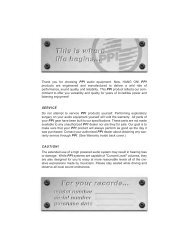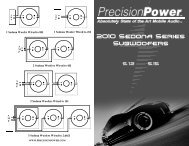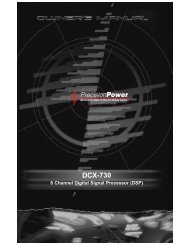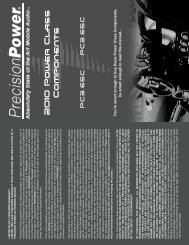CONTENTS - Precision Power
CONTENTS - Precision Power
CONTENTS - Precision Power
You also want an ePaper? Increase the reach of your titles
YUMPU automatically turns print PDFs into web optimized ePapers that Google loves.
Tools/Parts Needed for Installation (not supplied)<br />
Small flat blade screwdriver<br />
Phillips screwdriver (#2 or medium sized)<br />
Wire cutters<br />
Wire strippers<br />
4 – #6 round head screws, and 1 – #8 sheet metal screw<br />
(or nut, bolt, and star washer)<br />
2 – Ring connectors (large enough to accommodate your method of grounding)<br />
In-line fuse or circuit breaker — see fuse requirements below<br />
<strong>Power</strong> and groundwire — see <strong>Power</strong> Wire Calculator on the next page<br />
Speaker wire — 16 gauge or larger<br />
Grommets (sized to work with the power wire you plan to use in your installation)<br />
Tube of silicone sealant<br />
Fuse Requirements<br />
Recommended Fuse Rating for TD2200 i s 100 Amps<br />
Recommended Fuse Rating for TD225A is 100 Amps<br />
You will need to install an in-line fuse or circuit breaker in the power wire<br />
within 18” of the battery. This fuse or circuit breaker protects your vehicle<br />
from fire in case the power wire shorts to the vehicle body. If you are only using<br />
one amplifier, use the recommended fuse rating. If you are using more than one<br />
amplifier, add up the fuse ratings for all amplifiers, and use this sum for your main<br />
fuse or circuit breaker. Use a power distribution block or fuse near your amplifiers<br />
with the appropriate fuse for each individual power wire.<br />
The information below is a basic formula you can use to determine approximate<br />
current draw. A 50% amplifier efficiency rating is used as an average. This formula<br />
is only a guideline. Using wire of a larger gauge can only improve the current transfer<br />
of your system. Do not use smaller gauge wire.<br />
Total 4-Ohm rated RMS output x 2 = Total Input Wattage<br />
Total Input Wattage/Supply Voltage = Current Draw (in Amps)<br />
Example: A TD275 has 2 channels at 75 watts per channel RMS into 4-Ohms<br />
(75 x2 =150). You would use the formula below:<br />
150W x 2 = 300W/12.5V = 24 Amps Total Current Draw<br />
2<br />
BACK TO <strong>CONTENTS</strong>

















